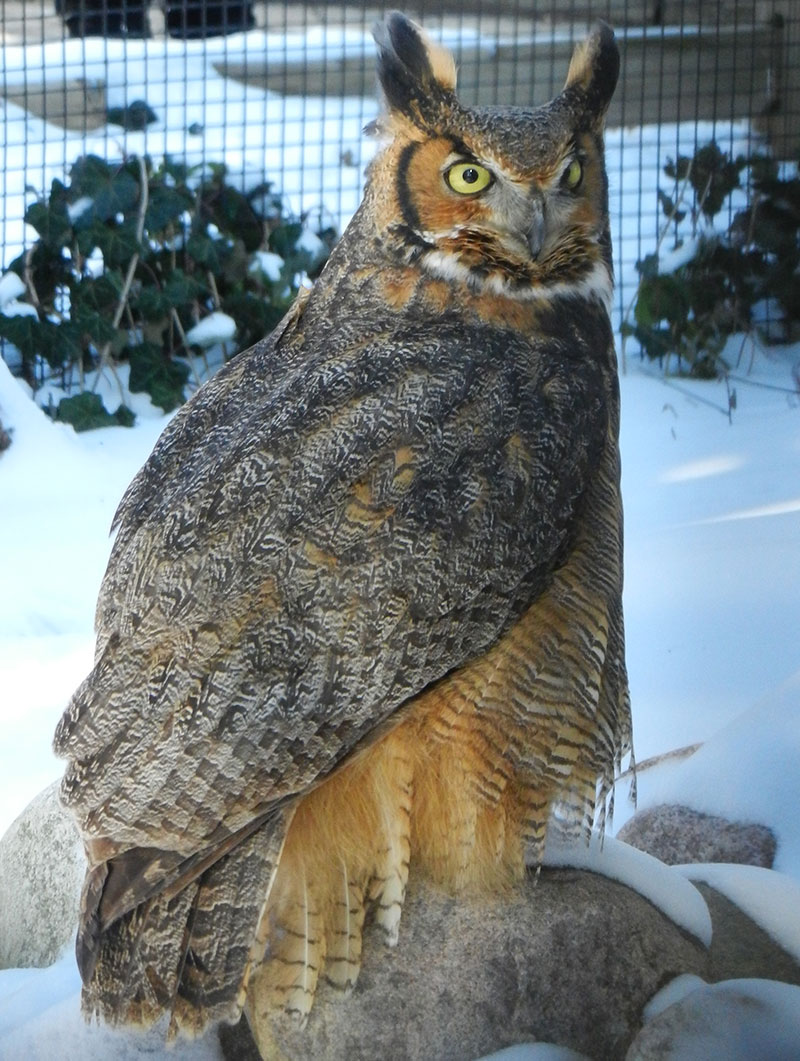Great Horned Owl
Bubo virginianus
Description:
Great horned owls are dark brown with black bars across their body. Their undersides are dark in color and they have white throats. They have tufts of feathers atop their heads that resemble horns, and their eyes are large and yellow.
Size:
The great horned owl is one of the largest owl species, weighing in at 2-4 pounds (0.9-1.8 kg) with a length of 18-25 inches (45.7-63.5 cm) and a wingspan of 3 to 5 feet (0.9-1.5 m). Females are larger than males.
Adaptations:
Owls are efficient predators and have many unique adaptations that increase their hunting abilities.
- The tips of their wing feathers are fringed, allowing them to fly without making any sound.
- Instead of being spherical, owls’ eyes are shaped like cylinders to help them see well in the dark.
- The tubular shape of owls’ eyes prevents the eyes from rotating in their sockets. To compensate for this, owls have extra vertebrae in their necks that enable them to turn their heads up to 270 degrees around.
- An owl’s eye is protected by three eyelids: an upper lid, a lower lid, and a nictating membrane that protects the owl’s eye while it is flying.
Diet:
Great horned owls eat a wide variety of prey. Cottontail rabbits make up a large part of their diet, but they will also eat squirrels, skunks, snakes, domestic cats, and a wide variety of birds. At Cosley Zoo, the great horned owls are fed quail, chicken, and mice.
Reproduction:
Great horned owls are some of the earliest nesting birds. Eggs may be laid beginning in January or February. Great horned owls can use the abandoned nests of other birds, or build their own nests in rock alcoves, hollows of trees, abandoned buildings, or sometimes on the ground. Females lay an average of two or three white-shelled eggs, with a maximum of six eggs per clutch. The male and female work together to incubate the eggs for 30-35 days. The young are fed by both parents, who fiercely defend their nest site against intruders. The young fledge (begin to fly) at 45-55 days old.
Shelter and space needs:
Great horned owls inhabit woods, mountain forests, desert canyons, marshes, city parks, and urban forests. They prefer open areas or nest sites close to the edge of a forest where they can hunt.
Life expectancy:
It has been difficult to determine the longevity of great horned owls in the wild. In human care, these owls have lived into their twenties.
Relationship with man:
Great horned owls are at the top of the food chain and as predators, they are important for keeping populations of rats and mice under control. People have long been fascinated with owls and they are often used as subjects of folklore and symbols of wisdom.
Fun Facts:
- Because they do not possess a sense of smell, the great horned owl is one of the only predators of skunks!
- Since great horned owls nest so early in the year, the parent who is incubating the eggs often becomes covered with snow.
- Groups of small birds will sometimes mob an owl and successfully chase it away.
- If weighed together, a great horned owl’s eyes will weigh almost one ounce – more than those of a 200-pound human!






